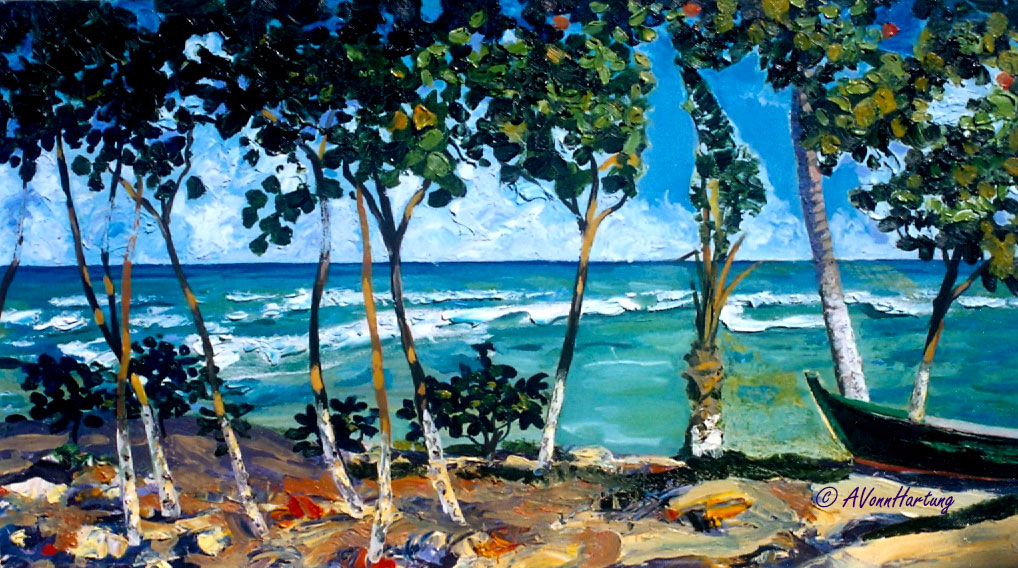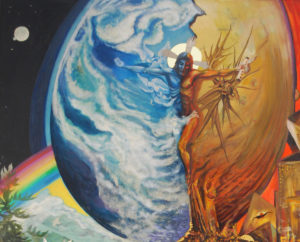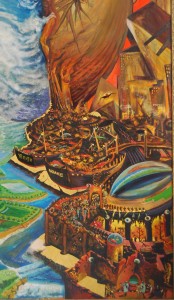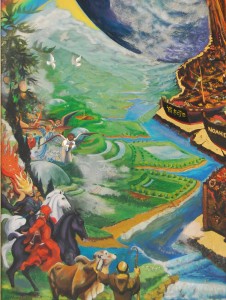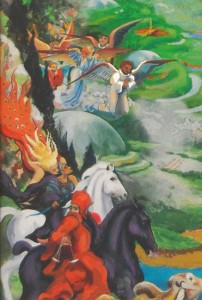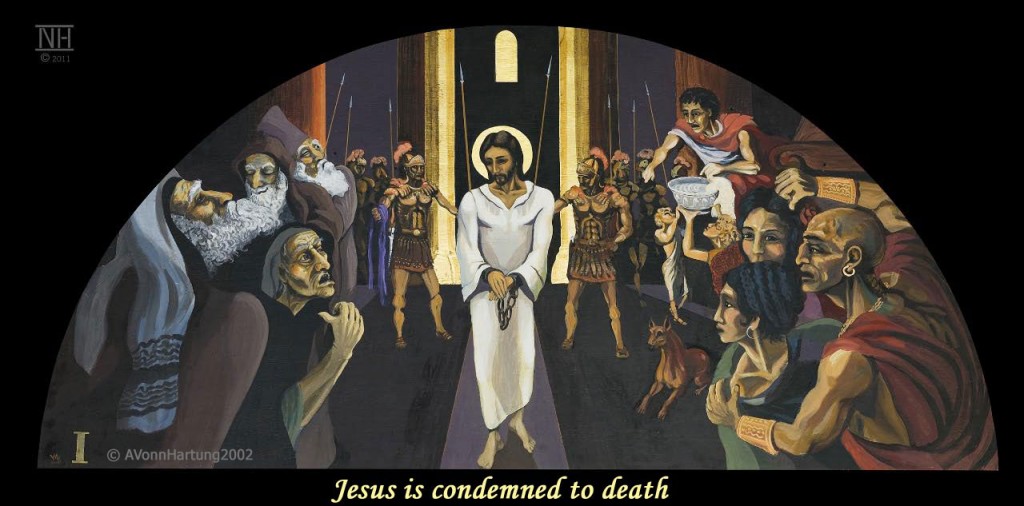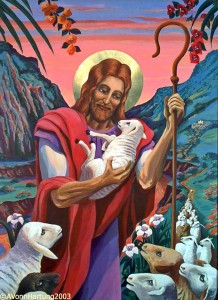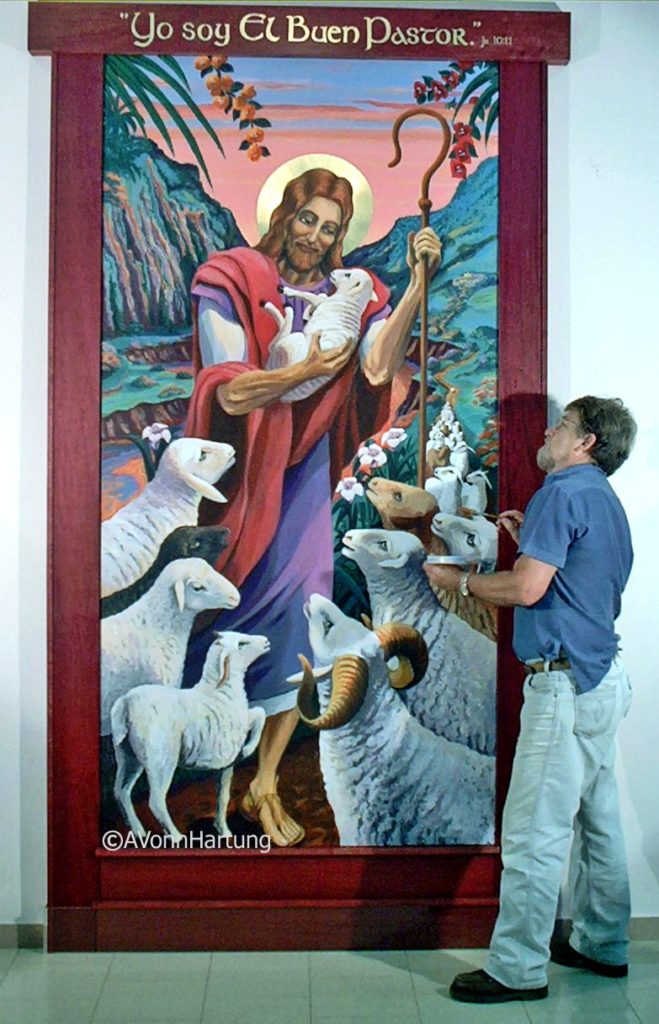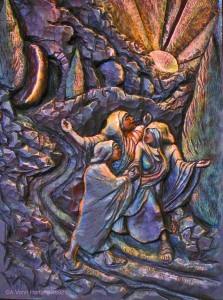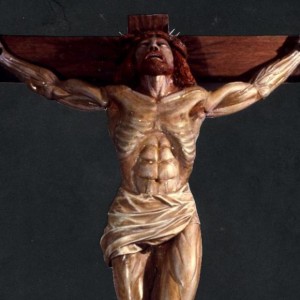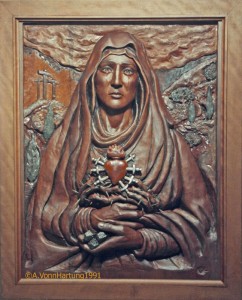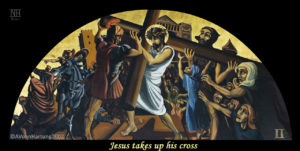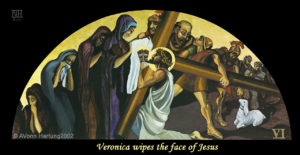Dando respuesta al llamado del Santo Padre, Papa Francisco, al diálogo y a la acción sobre el cambio climático en su encíclica “Laudato Si’, sobre el Cuidado de la Casa Común”, publicado en 2015, ofrezco esta pintura metafórica, “Así en la Tierra Como en El Cielo” (una oración visual) como una contribución al proceso de concienciación y para avivar el diálogo.
Compre una impresión giclée de esta pintura.
[Read in English]
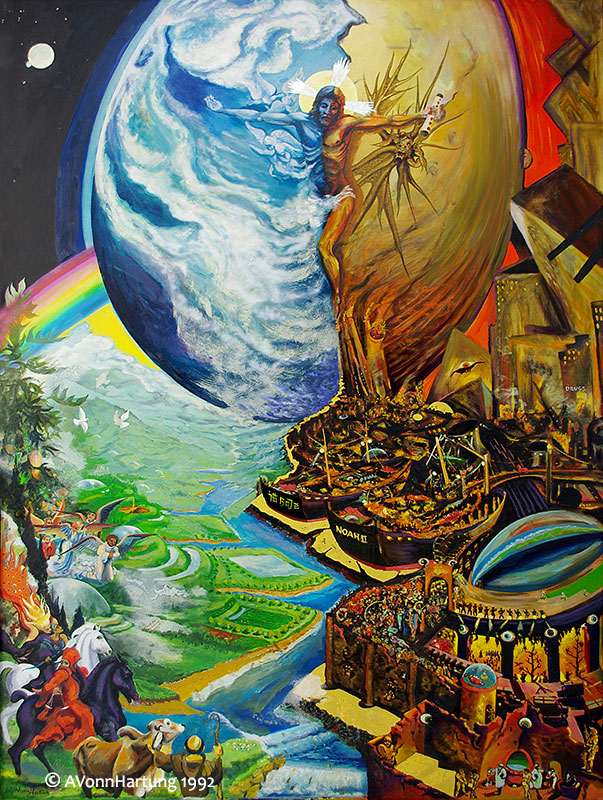
El título de la pintura Así en la Tierra como en el Cielo surge de la oración que Cristo Jesús nos enseñó, el Padre Nuestro, “Venga A Nosotros Tu Reino, Hágase Tu Voluntad, Así en la Tierra Como En El Cielo”
La pintura presenta un concepto retórico y nos ofrece solamente dos posibilidades.
La primera está en armonía con la Creación de Dios, un futuro de justicia, paz y sustentabilidad en el mundo natural. La segunda conlleva saqueo, caos, guerra interminable y un derrumbamiento final de la naturaleza y de la vida en nuestro hogar planeta como lo hemos conocido hasta ahora.
La pintura interroga y confronta al observador, a cada uno, irrespectivamente de su religión o creencia, ¿en cuál ambiente queremos vivir y dejar a nuestros hijos y a las generaciones futuras?
Dios nos está dando una opción.
Desde la perspectiva cristiana, Dios nos dió el libre albedrío cuando en el jardín del Edén le permitió a Adán escoger si comía o no del fruto prohibido (Gen. 2,16) además de haberle dado consciencia e inteligencia. Adán escogió no escuchar a Dios y le desobedeció.
Dios nos dió una segunda oportunidad al enviarnos a Su Hijo Jesucristo a redimirnos de nuestros pecados. Una vez más no le escuchamos; y nosotros (la humanidad) la élite poderosa y los desinformados le rechazamos y crucificamos.
Ahora, Dios, de nuevo nos está ofreciéndonos otra oportunidad, hablándonos a través de su Vicario en la tierra, el Papa Francisco, desde la creación en la espantosa extinción de las especies desde los orígenes de la revolución industrial, los eventos horrendos resultantes del cambio climático, el sufrimiento de los pobres y nuestras guerras interminables.
¿Una vez más NO ESCUCHAREMOS a Dios, no haremos Su voluntad si no la nuestra? Le ignoraremos y continuaremos nuestro tonto y destructivo caminar hacia la aniquilación?
San Francisco nos llama.
En su encíclica, el Papa Francisco nos habla de San Francisco de Asís cuyo nombre tomó cuando lo hicieron Pontífice, y nombraba al Santo ‘como el Santo Patrón de todos los que estudian y trabajan en el área de ecología’ (L.S.10). Así es que vemos a San Francisco en primer plano de la pintura junto al buey fiel, símbolo del evangelio de San Lucas y los Hechos de los Apóstoles quienes nos ofrecen el espectáculo y nos hacen conscientes de la opción crucial que se nos presenta, una decisión que tenemos que tomar.
Nuestra decisión nos hace preguntarnos que si nosotros desenfrenadamente destruimos la sagrada creación de Dios por nuestra auto-decepción, apatía, orgullo o avaricia; ¿no estaríamos blasfemando contra Dios y no sería esto como el pecado de Lucifer, el ángel favorito de Dios que cayó por su envidia y orgullo, atreviéndose a retar y rebelarse ante El?
Las metáforas del huevo y el oro
En el centro de la pintura vemos el planeta Tierra, “Nuestra Casa Común” en un lado un estado vivible, saludable, vibrante y mientras que en el otro lado es lugar árido, inhabitable y mortalmente estéril.
Sobreimpuesto a la Tierra está Cristo, el Centro de la Creación “En El todas las cosas fueron hechas” (Juan 1,3). En Su mano derecha extendida sostiene siete estrellas, símbolo de Esperanza, más arriba hacia Su derecha, nuestra habitación de la luna significando un futuro de infinitas posibilidades.
En la otra mano, no obstante, Cristo agarra el pergamino sellado del Apocalipsis, detrás del que se ven las temidas plagas que serán descargadas si se rompieran los sellos.
La Tierra es pintada en forma ovalada, simbolizando metafóricamente la fragilidad del ecosistema de la Tierra así como su abundancia y fertilidad natural.
La metáfora del huevo también representa la rotura de la alianza y así la ruptura resultante de la frágil ecología y la caída de la humanidad de la gracia causada por un sistema económico lineal defectuoso basado en el mal uso del poder y de las riquezas, simbolizado en el uso impío del oro.
En el simbolismo cristiano el Oro tradicionalmente se ha utilizado para representar la Luz Increada de Dios, la divinidad, como en las aureolas de los santos y en la pintura, la aureola de Cristo.
El oro lo hemos utilizado aquí en la parte inferior de la pintura como si gotereara de la hendidura del huevo o centelleante como relámpago para simbolizar la envidia y la avaricia que desea y logra un dominio y control ulterior de los recursos y riquezas del mundo y que define la fractura y el Muro de Separación entre los dos futuros posibles.
La Tierra está contaminada por su gente.
Detrás de este Muro de Separación que parece gritar con dolor y quejas, se extiende un mundo que colapsa pintado en un conjunto de colores siena de edificios sombreados y quemados que se derrumban unos contra otros.
Doquier se evidencia la violencia (Isaías 24,5) ‘La tierra está profanada bajo sus habitantes que violaron la ley, trastocaron el decreto, rompieron el pacto perpetuo.’
Burbujas de biósfera exclusivas
Entre las estructuras de terrenos desolados están las pirámides que nos recuerdan el culto de los muertos y una cúpula majestuosa dominante de una bioesfera que recuerda el intento de crear un espacio terrestre habitable contrapuesto a la exploración del espacio sideral habitable viable en la estación lunar.
Esta bioesfera sugiere que el único espacio para vivir que se pueda lograr en un futuro lugar tan inservible pudiera ser viviendas altamente custodiadas y privatizadas de los más acaudalados.
Rodeando esta ‘’Burbuja” está la evidencia del precio que pagamos por sostener esta empresa exclusiva y segura, un comercio de esclavitud custodiado por dominio bruto y alimentado por el intercambio (tráfico) de partes del cuerpo humano y tejidos de los desaparecidos a través de los horrores de la deshumanización.
Los siete pecados mortales están implicados aunque velados parcialmente por el uso de la abstracción lo cual aduce a la pérdida de los valores morales y la naturaleza efímera y siempre cambiante de la modernidad.
La insensatez de no hacer la Voluntad de Dios y escuchar el reclamo de vivir en la sostenibilidad se expresa en el intento flaco de los orgullosos y poderosos para salvar lo que queda de la Creación mediante la construcción de un arca, y la absurdidad de tener que construir una segunda arca.
Haciendo contraste con este rostro infernal está el lado floreciente de la pintura que muestra un futuro simbolizado por el constante flujo de aguas vivas que nutren la creación, aguas del Bautismo, las que surgen del costado de Jesús.
Un mundo sostenible
Al lado de esta agua vemos el cultivo de la agricultura y aqua-cultura sostenible, así como edificios que se construyen en la tierra para preservar energía y para la protección de otros desastres naturales.
El paisaje es sereno y aparentemente escasamente poblado lo cual sugiere comunidades autosuficientes inteligentemente diseñadas donde el transito constante en las supercarreteras es innecesario. Es un mundo en armonía interna!
En medio de esta Visión Esperanzadora se ven un conjunto de ángeles que acompañan a Los Jinetes del Apocalipsis, que según avanzan son atajados por el Angel que (imaginamos) les susurra, ¡Esperen! La humanidad todavía tiene tiempo y la Voluntad libre para cambiar sus proceder y hacer la voluntad de Dios!
Esto sólo puede suceder si renunciamos a nuestra fantasía voraz de crecimiento económico ilimitado y de ser todopoderosos y separados de la Naturaleza.
Tenemos que lograr encontrar la sabiduría y acoger la visión de San Francisco, la oración que Su Santidad hace por nosotros en su encíclica Laudato Si’, palabras de Amor y Sabiduría, que responden “al clamor de la tierra y al clamor de los pobres” [L.S. 49] y la oración que el mismo Cristo nos enseñó en el Padre Nuestro,
“Venga a nosotros Tu Reino, Hágase Tu Voluntad así en la Tierra como en el Cielo…” que nos urge a cambiar nuestro proceder, hacer Justicia, vivir en la relación correcta con los demás y la Naturaleza, en armonía con nuestro planeta, la creación de Dios y el regalo que nos hace a todos, “Nuestra Casa Común” [L.S].
Amén.
Traducción por Norma T. Diaz Camacho
En Abril de 1996, esta pintura “Hágase tu Voluntad” estaba expuesta en la Iglesia San Ignacio, donde presenté una charla con reflexiones (publicada en “El Nuevo Dia” 22 de abril 1996) sobre lo que me motivó a crear esta obra.
NOTA: Esta pintura ha sido publicada en el libro de texto católico: “The Church Foundations and Mission” (Los fundamentos y la misión de la Iglesia), High School Framework Course 4 (Curso Marco de la escuela secundaria 4), por Carrie J. Schroeder, MDiv, EdD ©2020 St. Mary’s Press.
Esta pintura ha sido expuesta en el Centro de Bellas Artes Alejandro Cruz Ortiz, Guaynabo, Puerto Rico, del 26 de marzo al 26 de junio de 1998; en el Departamento de Estado, San Juan, Puerto Rico, durante la Cuaresma de 2011; en la Universidad del Este Ana G. Méndez, Carolina, Puerto Rico, durante la Cuaresma de 2005; en la Parroquia San Ignacio de Loyola, San Juan, Puerto Rico, en 2023; y en numerosos espacios públicos e iglesias de Puerto Rico.
Compre una impresión giclée de esta pintura.
